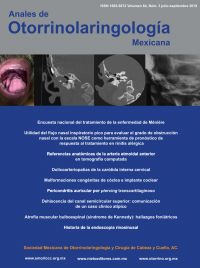Utility of the peak nasal inspiratory flow to evaluate the degree of nasal obstruction according to the NOSE scale as a prognostic tool for response to treatment in allergic rhinitis.

An Orl Mex. 2019 julio-septiembre;64(3):84-90.
Nayeli Elizabeth Martínez-Salazar,1 Olga Luz Márquez-López2
1 Otorrinolaringólogo, Servicio de Otorrinolaringología, Departamento de Cirugía General, Hospital General de Zona núm. 2, Instituto Mexicano del Seguro Social, Zacatecas, México.
2 Otorrinolaringólogo, práctica privada y adscrito al Servicio de Otorrinolaringología, UMAE núm. 1, Instituto Mexicano del Seguro Social, Bajío, León, Guanajuato, México.
Resumen
OBJETIVO: Determinar la eficacia del uso del flujo nasal inspiratorio pico para evaluar su correlación con el grado de obstrucción nasal como herramienta de pronóstico de respuesta al tratamiento para elección de tratamiento conservador o quirúrgico en pacientes con rinitis alérgica.
MATERIAL Y MÉTODO: Estudio analítico de correlación mediante muestreo simple no probabilístico de casos consecutivos, prospectivo y analítico de los pacientes de la consulta externa de otorrinolaringología con rinitis alérgica que refirieron obstrucción nasal entre sus síntomas de agosto a octubre de 2017. Se realizó valoración inicial y seguimiento a 30, 60 y 90 días con la escala NOSE; se clasificaron los cornetes inferiores mediante rinoscopia anterior y se midió el flujo nasal inspiratorio pico previo y posterior a la aplicación de fenilefrina.
RESULTADOS: Se incluyeron en el estudio 46 pacientes con rinitis alérgica con obstrucción nasal, 19 eran hombres (41.3%); la media de edad fue de 42.7 ± 13.1 años. Entre la escala NOSE y el flujo nasal inspiratorio pico se encontró que la correlación inicial previo a fenilefrina fue de –0.015, posterior a fenilefrina –0.243, a 30 días 0.093 y –0.209, a 60 días –0.195 y –0.244, respectivamente; no se encontró correlación.
CONCLUSIONES: El flujo nasal inspiratorio pico no es una herramienta útil para la elección del tipo de tratamiento de la obstrucción nasal en pacientes con rinitis alérgica, debido a que la correlación con la escala NOSE fue menor a 0.45.
PALABRAS CLAVE: Rinitis alérgica; obstrucción nasal; fenilefrina.
Abstract
OBJECTIVE: To determine the efficacy of the use of peak nasal inspiratory flow to evaluate its correlation with the degree of nasal obstruction as a predictive tool for response to conservative or surgical treatment in patients whit allergic rhinitis.
MATERIAL AND METHOD: A correlation analytical study was carried out by means of simple non-probabilistic sampling of consecutive cases, prospective and analytical of the patients of the otolaryngology outpatient clinic, with allergic rhinitis that referred nasal obstruction among their symptoms from August to October 2017. Initial assessment and follow-up were performed at 30, 60 and 90 days with the NOSE scale, inferior turbinates were classified by anterior rhinoscopy and the peak nasal inspiratory flow was measured before and after the application of phenylephrine.
RESULTS: Fourty-six patients with allergic rhinitis with nasal obstruction, 19 men (41.3%), with a mean age of 42.7 ± 13.1 years, were included in the study. Between the NOSE scale and peak nasal inspiratory flow it was found that the initial correlation prior to phenylephrine was –0.015, after phenylephrine –0.243, at 30 days 0.093 y –0.209, at 60 days –0.195 y –0.244, respectively, so, no correlation was found.
CONCLUSIONS: Peak nasal inspiratory flow is not a useful tool for choosing the type of treatment for nasal obstruction in patients with allergic rhinitis, since the correlation with the NOSE scale was less than 0.45.
KEYWORDS: Allergic rhinitis; Nasal obstruction; Phenylephrine.

